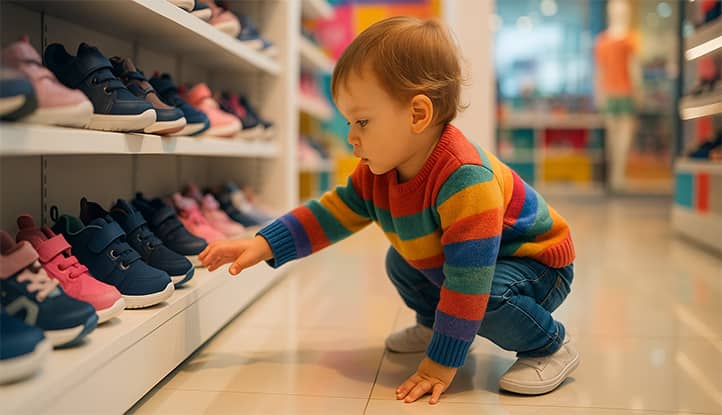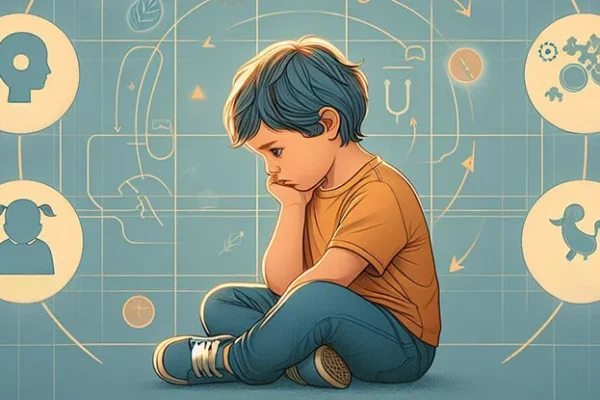Every parent knows how important it is to choose comfortable shoes for their child—after all, the health of little feet depends on it. But few people think about how shoes affect not only the formation of the foot but also the emotional state, behavior, and even the socialization of the child. Physical discomfort from tight or uncomfortable shoes can make a child cranky, anxious, or unwilling to move, while favorite bright sneakers, on the contrary, bring a sense of confidence and joy.
Choosing children’s shoes is not just a question of orthopedics or practicality. It’s also a subtle psychological moment. Children perceive the world through sensations, and what’s on their feet is directly linked to their mood and self-perception. For example, stiff, inflexible shoes may be associated with constraint and even fear of taking a wrong step, while soft, lightweight sandals—with freedom and the desire to run and play. Moreover, the appearance of the shoes, their color and design, often become a way for the child to express themselves.
A vivid example is the story of a three-year-old girl who flatly refused to wear the new shoes her mother bought, even though they were “correct” from an orthopedic standpoint. The little girl cried and took them off at the first opportunity, and when the parents finally asked what was wrong, it turned out she simply didn’t like the “scratchy” strap and the “too loud” squeak of the sole. In the end, switching to softer, more pleasant-to-touch shoes instantly changed the child’s mood—she became active and cheerful again.
This case clearly shows: children’s shoes are not just an accessory but an important element of psychological comfort. And while adults often choose shoes based on size, season, and orthopedic recommendations, for a child, it’s much more important that they feel cozy, fun, and “like their favorite character’s.”
In this article, we’ll explore how shoes affect a child’s psyche, why some models delight while others provoke protest, and how to find a balance between health, comfort, and children’s emotions.
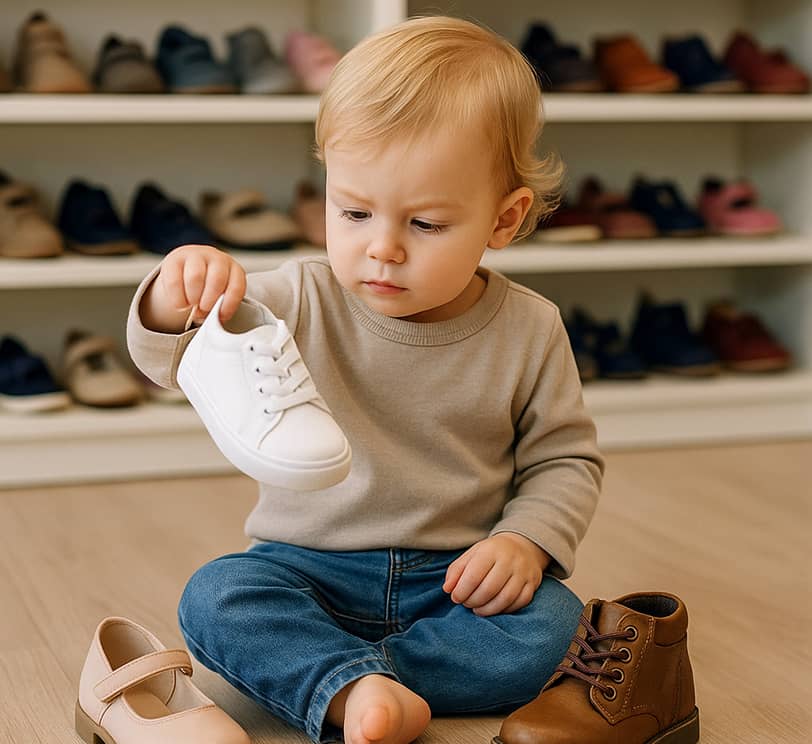
First Steps: How Shoes Shape Confidence
A child’s first steps are not just a physical skill but an entire adventure full of discoveries and emotions. And in this journey, shoes play a much more important role than it might seem at first glance. Well-chosen shoes can become reliable helpers, giving the child a sense of support and security, while uncomfortable ones can turn every step into an ordeal.
Many parents focus on ensuring shoes are “orthopedically correct,” but they forget that for a child, how they feel in motion is far more important. Stiff, heavy, or inflexible shoes can not only slow down the process of learning to walk but also affect the child’s emotional state, depriving them of the joy of their first independent steps. Let’s explore how shoes help or hinder a child’s confidence.
The Role of First Shoes in Learning to Walk
First shoes are a kind of “trainer” for little feet, helping the child adapt to a new way of moving. Ideally, they should serve several functions:
- Support without restricting. Too stiff shoes limit the foot’s natural movement, preventing the child from feeling the surface and properly distributing their weight. At the same time, shoes with no support at all (like soft booties) don’t provide enough stability for unsteady first steps.
- Protect without isolating. The sole should shield the feet from cold, sharp objects, and slipping, but still allow the child to “feel” the ground—this is crucial for developing balance and coordination.
- Be lightweight and comfortable. Heavy boots or high-top shoes can tire the child, making every step difficult and unpleasant.
Interesting fact: Studies show that children who learn to walk in properly fitted shoes master this skill faster and with less stress than those who wear uncomfortable models or walk barefoot on slippery floors.
Fear of Falling and Discomfort: How Stiff Soles or Poor Fit Hinder a Child
Imagine taking your first steps in stiff ski boots—it’s unlikely to be a joyful experience. For a child, uncomfortable shoes create a similar sensation:
- Stiff soles interfere with the foot’s natural roll, causing the child to trip and fall more often. This isn’t just painful but also scary—after a few failures, some children start fearing independent walking, preferring to crawl or hold an adult’s hand.
- Tight toe boxes or high backs can cause real pain, especially if the shoes are a tight fit. A child doesn’t yet know how to explain that they feel cramped, so they express discomfort through fussiness, tears, or refusing to walk.
- Slippery soles (for example, on smooth hardwood floors) force the child to tense up with every step, robbing them of confidence.
Why Some Children Take Off Their Shoes and Prefer Walking Barefoot (Sensory Traits)
Many parents face their child stubbornly removing shoes at the first opportunity. This isn’t always a whim—often, it’s due to sensory traits:
- Hypersensitivity. Some children find even soft socks or lightweight sandals physically unpleasant—they feel every seam, strap pressure, or temperature change inside the shoe. For them, walking barefoot is a way to escape discomfort.
- Lack of tactile input. The soles of the feet are one of the most sensitive areas in toddlers. Through contact with different surfaces (grass, sand, warm floors), they explore the world. Shoes, especially closed ones, deprive them of this opportunity.
- Need for freedom. Tight shoes may feel restrictive to a child, especially if they’re naturally active.
What to do? Instead of forcing them to wear shoes “against their will,” try:
- Choosing models with minimal internal seams and soft edges.
- Allowing barefoot walking at home and on safe surfaces (like sand).
- Using shoes with textured insoles—this provides extra sensory stimulation.
Important: If a child constantly removes their shoes, check if they’re too small or rubbing. If it’s a sensory trait, gradually acclimate them to wearing shoes, starting with just a few minutes a day.
Thus, first shoes are not just “foot protection” but an important tool that helps a child feel confident in the new world of walking upright. When choosing shoes, it’s worth considering not just size and seasonality but also how they affect the child’s movements, emotions, and desire to explore the world.
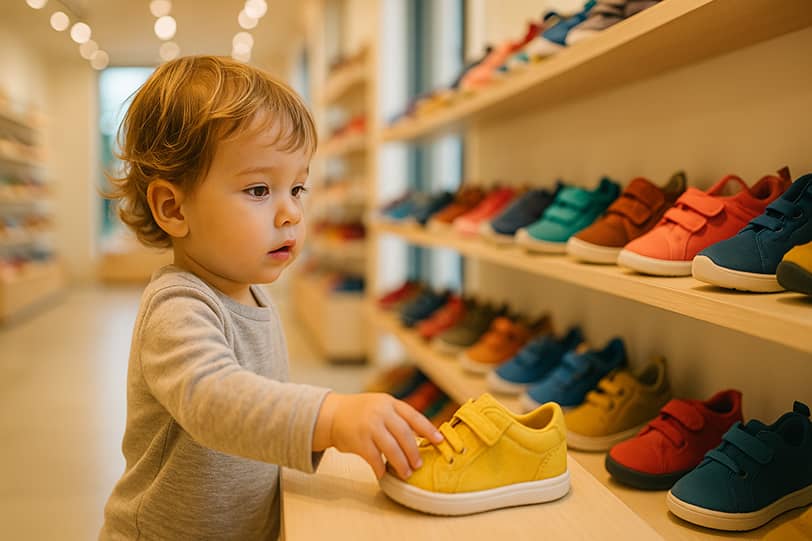
Color, Design, and Children’s Preferences: How Shoe Appearance Affects a Child
For adults, shoes are primarily a practical wardrobe item, but for children, they’re a whole world of emotions and self-expression. Kids perceive their clothes and shoes as part of themselves, so their choices often seem illogical: one child flatly refuses to wear comfortable shoes just because they’re “ugly,” while another is willing to endure tight boots if they feature a favorite character.
Psychologists note that through shoe preferences, children not only express their personality but also form their first ideas about themselves. Bright colors, beloved characters, or unusual designs become their way of declaring: “This is me!” And if parents ignore these signals, dismissing them as whims, they may unintentionally deprive the child of an important tool for self-expression. Let’s explore why shoe appearance is so crucial for a child’s psyche.
The Influence of Color on a Child’s Mood and Activity
Color is a powerful emotional catalyst that affects children more strongly than adults. By choosing shoes of a particular shade, parents can unknowingly influence their child’s behavior:
- Red, orange, bright yellow — energize, suit active children, but may overstimulate sensitive kids.
- Blue, green, purple — have a calming effect, help with focus. Ideal for anxious or hyperactive children.
- Pastel tones (pink, light blue, mint) — create a sense of security. Often chosen by shy children.
- Dark colors (black, gray) — may dampen mood but appeal to kids who want to appear “grown-up.”
Tip: If a child categorically refuses shoes of a certain color, don’t insist—this shade might genuinely cause subconscious discomfort.
Characters and Prints: Why Do Children Get So Attached to Shoes Featuring Favorite Characters?
For a child, the image on their shoes isn’t just a picture—it’s a real “talisman” and a source of confidence:
- The superhero effect. Wearing sneakers with Spider-Man or Batman, a child subconsciously adopts the character’s traits—becoming braver, more sociable. Psychologists call this “costumed identification.”
- Support in stressful situations. Many children find it easier to go to kindergarten or the doctor if their shoes have a “friend”—a familiar cartoon character.
- A social marker. At ages 4–7, shoes with popular characters help kids make friends—children immediately spot shared interests.
“I Don’t Want These Sandals!” — How Rejecting Certain Shoes Relates to Self-Identity
When a child stubbornly insists on choosing their shoes, they’re asserting their individuality:
- Rebelling against “childishness.” Kids often reject shoes with teddy bears or bows because they want to look “grown-up.” This is especially common during the 3-year-old crisis and in teenagers.
- Gender self-identification. A boy might refuse red boots (“those are for girls!”), even if they’re comfortable—this is how they internalize social norms.
- Mismatch with their self-image. An active child will resist wearing formal shoes, while a calm one might reject bright neon sneakers.
What parents can do:
- Offer several age- and gender-appropriate options but allow the child to choose.
- Respect preferences if they don’t harm health (e.g., allowing “inappropriate” colored sneakers).
- Turn “disliked” but necessary shoes (like winter boots) into a creative project—add sparkles or draw patterns together.
Important: A categorical refusal to wear certain shoes is rooted in psychology 70% of the time. Before insisting, try calmly asking: “What don’t you like about them?” The issue might not be the shoes themselves but what they symbolize to the child.
Thus, shoe color and design aren’t just about aesthetics—they’re a key element of a child’s psychological comfort. By considering a child’s preferences, parents help them develop healthy self-esteem, learn to make choices, and express their individuality.
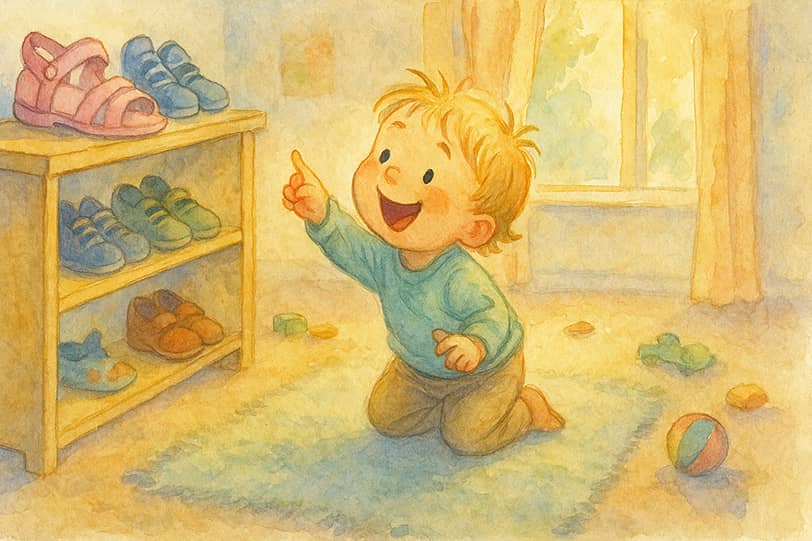
Shoes and Social Adaptation: How Children’s Footwear Affects Social Standing
From the first years of kindergarten, shoes become more than just a necessity for a child—they serve as an important social marker. Children quickly notice differences between their belongings and those of their peers, forming their first notions of social status. In a children’s group, shoes can be either a source of pride or a cause of insecurity, depending on how well they align with the group’s “unwritten” rules.
Psychologists note that as early as 3-4 years old, children begin to recognize the symbolic meaning of clothing and shoes. By 6-7 years, this awareness intensifies—clear ideas of “fashionable” and “unfashionable” footwear emerge. Parents need to understand these dynamics to help their child navigate social adaptation without unnecessary distress. Let’s examine how shoes influence children’s relationships.
How Children Compare Their Shoes to Others’: When Do Envy or Pride Emerge?
The comparison process begins earlier than many parents realize:
- At 2-3 years, children simply notice differences (“Vanya’s shoes sparkle!”) without assigning value judgments.
- At 4-5 years, the first emotional reactions appear: happiness if others like their shoes, or frustration if they’re “not the same.”
- By 6 years, conscious comparisons form, which can escalate into envy or pride.
Interesting fact: A study in kindergartens found that 65% of conflicts over “who has better things” start with discussions about shoes—they’re more noticeable than other clothing items.
How parents should respond:
- Don’t dismiss the child’s feelings (“Who cares what shoes you wear!”).
- Explain that different families have different means.
- Encourage focusing on comfort rather than appearance.
How Trendy Sneakers or “Uncool” Shoes Affect Status in a Child’s Group
Children’s groups develop their own unspoken hierarchies, where shoes often serve as a “pass” into certain circles:
- Status models (light-up soles, well-known brands) boost credibility among peers.
- Unfashionable shoes (outdated styles, worn-out appearance) can invite teasing.
- Unique designs help creative children stand out.
Real-life example: In one class, a boy who wore hand-painted sneakers was initially mocked but later became the most popular—kids lined up for him to customize their shoes too.
Parenting tips:
- Learn what shoes are considered trendy in your child’s group.
- Find a compromise between budget and current trends.
- Foster confidence in your child that isn’t tied to material possessions.
Example: A Child Is Ashamed of Old Shoes—What Should Parents Do?
When a child refuses to wear last year’s shoes for fear of judgment, a delicate approach is needed:
Do:
- Identify the root cause (specific teasing or general anxiety).
- Discuss the family budget in age-appropriate terms.
- Suggest ways to refresh the shoes (new laces, fun insoles).
- Host a “fashion show” at home to boost self-esteem.
Don’t:
- Mock the child’s concerns.
- Buy expensive shoes at the expense of the family budget.
- Forbid discussing the topic.
Psychological trick: Turn old shoes into “exclusive” items—create a backstory together (“These shoes traveled with us to the sea!”), add unique details.
Important: If the situation causes significant distress, discuss it with the teacher—the group dynamic may need addressing.
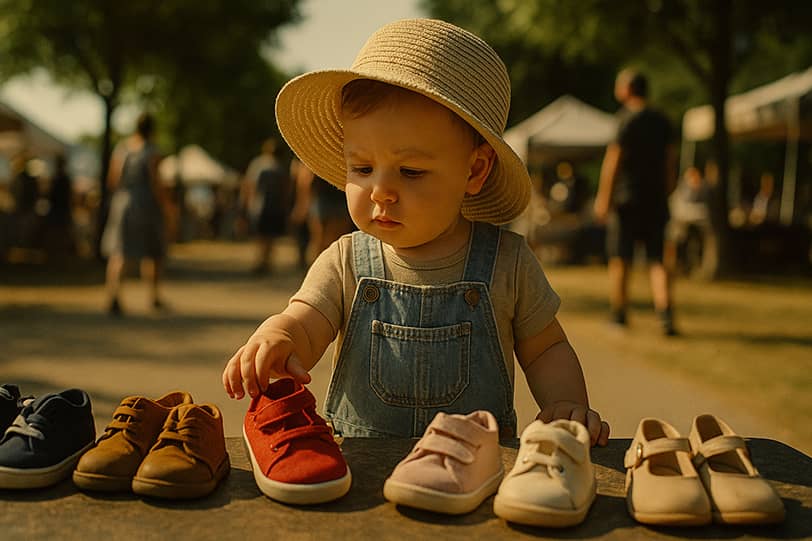
Comfort vs. Beauty: What’s More Important for a Child’s Mental Well-being?
Every parent faces a dilemma when choosing children’s shoes: buy a practical but plain pair or beautiful but uncomfortable ones? This choice may seem simple, but it directly affects a child’s psychological well-being. On one hand, uncomfortable shoes can cause daily stress; on the other, excessive focus on appearance fosters unhealthy values.
Children perceive shoes holistically—both tactile sensations and visual appeal matter to them. Parents must strike a balance between these needs so the child feels both physically comfortable and psychologically confident. Let’s explore how to make the right choice that benefits both little feet and a child’s mental health.
Consequences of Wearing Tight or Uncomfortable Shoes (Irritability, Anxiety)
Physical discomfort from improper footwear has direct psychological effects:
- Chronic stress: Constant pressure on the feet sends alarm signals to the brain. The child becomes fussy for no apparent reason.
- Reduced activity: Uncomfortable shoes limit movement. The child refuses to play games they once loved.
- Sleep disturbances: Tight shoes worn during the day can cause residual tension, making it harder to relax at night.
How Overemphasizing “Fashionable” Shoes Can Create Unrealistic Appearance Standards
Focusing solely on shoe appearance carries several psychological risks:
- Misdirected values: The child starts judging people (and themselves) by shoes rather than personal qualities.
- Social anxiety: Fear of “not fitting in” if their shoes aren’t trendy enough.
- Financial disconnect: Developing expectations beyond the family’s means.
Psychologists note a troubling trend: children aged 6-9 increasingly reject quality but unfashionable shoes, preferring uncomfortable yet “prestigious” models.
Prevention tips:
- Discuss with your child why comfort matters more than looks.
- Emphasize valuing items for practicality, not price tags.
- Limit exposure to advertising and “kid influencer” content.
The Golden Mean: Choosing Shoes That Are Both Comfortable and Aesthetically Pleasing
These strategies help find a compromise between comfort and beauty:
When selecting:
- First test for comfort (flexible sole, proper arch support).
- Then choose from comfortable options based on design.
- Look for “trendy” elements in practical models (light-up accents, removable bows).
In parenting:
- Cultivate the child’s personal taste rather than blind trend-following.
- Teach balancing practicality and beauty (“These sandals are comfy AND your favorite color”).
- Create positive associations with comfortable shoes (“You climb so high in these sneakers!”).
Important: If a child insists on uncomfortable but “pretty” shoes, compromise—reserve them for special occasions while choosing more practical footwear for daily activities.
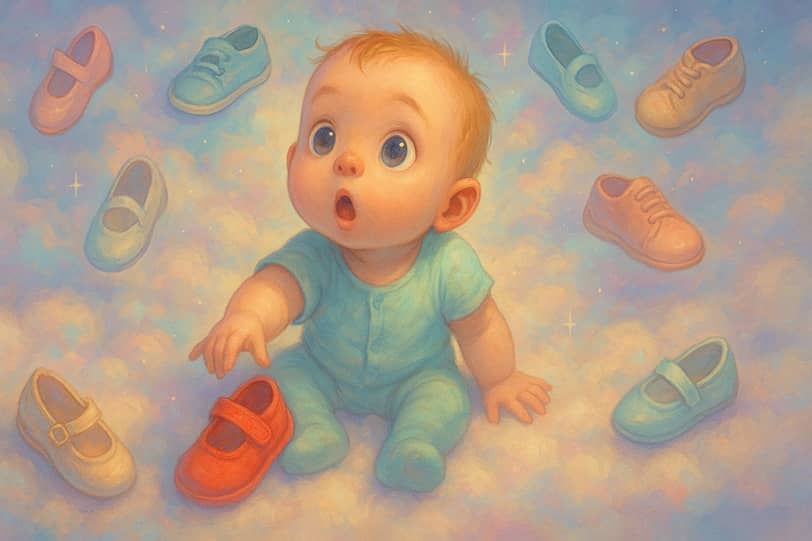
Rituals and Habits: The Psychology of Children’s Perception of Footwear
For children, shoes are not just a wardrobe item but an important part of their daily rituals and emotional comfort. Many parents notice how their child may wear the same sandals for months, rejecting new ones, or how tying shoelaces becomes a special ceremony. These habits are not mere whims but manifestations of deep psychological mechanisms through which children experience stability and control over their environment.
Children’s perception of footwear is closely tied to feelings of safety and independence. The same pair may be associated with positive memories, while new shoes can trigger anxiety about the unknown. By understanding these nuances, parents can gently guide their child’s habits without disrupting their psychological comfort. Let’s explore why children become so attached to certain shoes and how to use this knowledge in parenting.
Why Do Some Children Insist on Wearing the Same Pair for Months?
Attachment to specific footwear stems from several psychological factors:
- Familiarity effect: Worn-in shoes provide predictability in a changing world—especially important for anxious children.
- Tactile memory: A child’s foot memorizes the shape of favorite shoes, making new ones feel “foreign.”
- Emotional connection: Shoes may be linked to happy memories (“I slid down the slide for the first time in these boots”).
- Sensory sensitivities: Children with heightened sensitivity may find changing shoes genuinely stressful.
Parental guidance:
- Never discard old shoes without the child’s consent.
- Introduce new footwear gradually—start by wearing indoors for an hour.
- Maintain familiar routines (e.g., same lacing method).
The “Magic” of Laces and Velcro: How Fine Motor Skills Build Confidence
Closure types play a surprisingly significant developmental role:
Velcro (ages 2-4):
- Fosters first experiences of independence
- Develops hand-eye coordination
- Creates a sense of “I did it myself!”
Laces (ages 5-7):
- Teaches perseverance and patience
- Develops logical thinking (lace patterns)
- Boosts self-esteem through mastering an “adult” skill
Buckles and clasps:
- Teach cause-and-effect understanding
- Strengthen finger muscles
Psychological hack: Turn lacing into a ritual—create a story about “lace friends” who hug in special ways to ease a toddler’s frustration.
How to Introduce New Footwear Stress-Free
Make transitions smoother with these psychological techniques:
Stage 1: Preparation
- Mention 2-3 weeks in advance: “We’ll get new shoes soon!”
- Examine the new shoes together; point out special details (patterns, sparkles).
- Let the child choose from 2-3 comfortable options.
Stage 2: Familiarization
- Place the new shoes among toys in their room.
- Have them “try” the shoes on a favorite doll or stuffed animal.
- First wear: 15-30 minutes indoors.
Stage 3: Reinforcement
- Associate the shoes with a positive event (holiday, zoo trip).
- Keep familiar elements (same socks, insoles).
- Invent an adventure story about the new pair.
Important! If the child outright rejects new shoes:
- Check for real discomfort (rubbing, tightness).
- Suggest “customizing” (adding gems, changing laces).
- Use baby steps (left foot only today, both tomorrow).
These approaches preserve psychological comfort while nurturing adaptability. The key is respecting children’s rituals—understanding their emotional significance—while gently expanding comfort zones. This way, shoes become tools for confidence-building rather than stress sources.
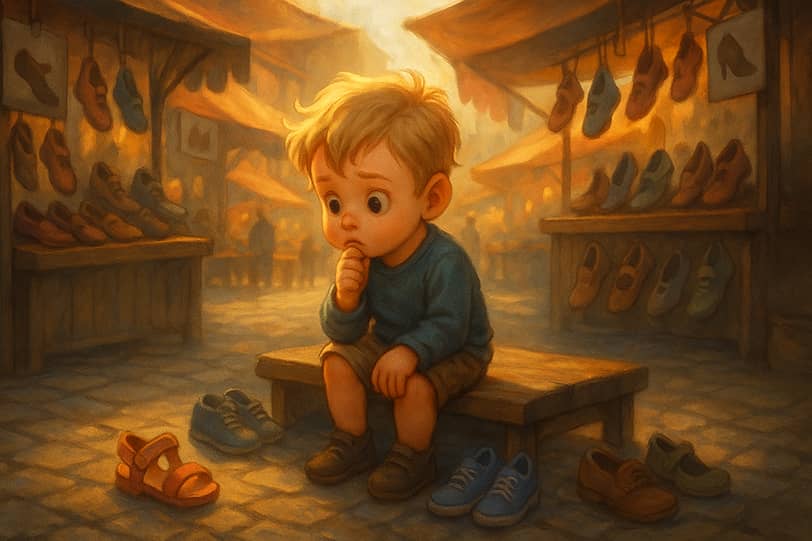
Conclusion
Choosing children’s footwear goes far beyond purchasing clothing. Every pair—boots, sandals, or sneakers—holistically impacts a child’s psyche, shaping their emotions, behaviors, and social interactions. Through this lens, we see how physical comfort intertwines with psychological well-being: uncomfortable shoes may irritate, while favorite character sneakers boost confidence in new settings.
Parents must consider all aspects: proper sizing, ergonomic design, color preferences, and peer trends. Special attention should go to transitions—seasonal changes, switching from Velcro to laces, first “grown-up” pairs. These moments often cause anxiety, requiring adults to facilitate smooth adjustments. Remember: even premium trendy shoes fail if a child refuses to wear them due to inner discomfort.
Ultimately, ideal children’s footwear is what they forget they’re wearing. When feet feel good, the look delights, and there’s no fear of peer judgment—these conditions foster balanced development.
Practice shows that children whose footwear needs (both physical and emotional) are met exhibit greater self-assurance, better social adaptation, and more independence. May every step your child takes be joyful—literally and figuratively—because the right shoes truly mean healthy feet and genuinely happy emotions.
